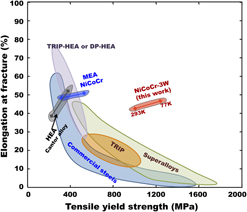Crossref Citations
This article has been cited by the following publications. This list is generated based on data provided by
Crossref.
Sathiyamoorthi, Praveen
Bae, Jae Wung
Asghari-Rad, Peyman
Park, Jeong Min
Kim, Jung Gi
and
Kim, Hyoung Seop
2018.
Effect of Annealing on Microstructure and Tensile Behavior of CoCrNi Medium Entropy Alloy Processed by High-Pressure Torsion.
Entropy,
Vol. 20,
Issue. 11,
p.
849.
Sathiyamoorthi, Praveen
Asghari-Rad, Peyman
Park, Jeong Min
Moon, Jongun
Bae, Jae Wung
Zargaran, Alireza
and
Kim, Hyoung Seop
2019.
Exceptional cryogenic strength-ductility synergy in Al0.3CoCrNi medium-entropy alloy through heterogeneous grain structure and nano-scale precipitates.
Materials Science and Engineering: A,
Vol. 766,
Issue. ,
p.
138372.
Sathiyamoorthi, Praveen
Moon, Jongun
Bae, Jae Wung
Asghari-Rad, Peyman
and
Kim, Hyoung Seop
2019.
Superior cryogenic tensile properties of ultrafine-grained CoCrNi medium-entropy alloy produced by high-pressure torsion and annealing.
Scripta Materialia,
Vol. 163,
Issue. ,
p.
152.
Wang, Jianying
Yang, Hailin
Ruan, Jianming
Wang, Yun
and
Ji, Shouxun
2019.
Microstructure and properties of CoCrNi medium-entropy alloy produced by gas atomization and spark plasma sintering.
Journal of Materials Research,
Vol. 34,
Issue. 12,
p.
2126.
Hu, G.W.
Zeng, L.C.
Du, H.
Liu, X.W.
Wu, Y.
Gong, P.
Fan, Z.T.
Hu, Q.
and
George, E.P.
2020.
Tailoring grain growth and solid solution strengthening of single-phase CrCoNi medium-entropy alloys by solute selection.
Journal of Materials Science & Technology,
Vol. 54,
Issue. ,
p.
196.
Ma, Huan
Shao, Yang
and
Shek, Chan Hung
2020.
CoCuFeNi high entropy alloy reinforced by in-situ W particles.
Materials Science and Engineering: A,
Vol. 797,
Issue. ,
p.
140218.
Gao, Y.F.
Zhang, W.
Shi, P.J.
Ren, W.L.
and
Zhong, Y.B.
2020.
A mechanistic interpretation of the strength-ductility trade-off and synergy in lamellar microstructures.
Materials Today Advances,
Vol. 8,
Issue. ,
p.
100103.
Fantin, Andrea
Lepore, Giovanni Orazio
Manzoni, Anna M.
Kasatikov, Sergey
Scherb, Tobias
Huthwelker, Thomas
d'Acapito, Francesco
and
Schumacher, Gerhard
2020.
Short-range chemical order and local lattice distortion in a compositionally complex alloy.
Acta Materialia,
Vol. 193,
Issue. ,
p.
329.
Rahul, M. R.
and
Phanikumar, Gandham
2020.
Experimental and simulation studies of solidification behaviour in undercooled CuCoNi equiatomic medium entropy alloy.
The European Physical Journal Special Topics,
Vol. 229,
Issue. 2-3,
p.
145.
Schneider, M.
George, E.P.
Manescau, T.J.
Záležák, T.
Hunfeld, J.
Dlouhý, A.
Eggeler, G.
and
Laplanche, G.
2020.
Analysis of strengthening due to grain boundaries and annealing twin boundaries in the CrCoNi medium-entropy alloy.
International Journal of Plasticity,
Vol. 124,
Issue. ,
p.
155.
Qin, Gang
Chen, Ruirun
Liaw, Peter K.
Gao, Yanfei
Wang, Liang
Su, Yanqing
Ding, Hongsheng
Guo, Jingjie
and
Li, Xiaoqing
2020.
An as-cast high-entropy alloy with remarkable mechanical properties strengthened by nanometer precipitates.
Nanoscale,
Vol. 12,
Issue. 6,
p.
3965.
Yi, Hailong
Bi, Mengyuan
Yang, Kang
and
Zhang, Bing
2020.
Significant Improvement the Mechanical Properties of CoCrNi Alloy by Tailoring a Dual FCC-Phase Structure.
Materials,
Vol. 13,
Issue. 21,
p.
4909.
Hausch, G.
2020.
Comment on the paper "On the formation of hierarchical microstructure in a Mo-doped NiCoCr medium-entropy alloy with enhanced strength-ductility synergy" by J. He, S.Makineni, W.Lu,Y.Shang,Z.Lu,Z.Li,B.Gault, Scripta Mater 175(2020)1-6.
Scripta Materialia,
Vol. 187,
Issue. ,
p.
1.
Rahul, M.R.
and
Phanikumar, Gandham
2020.
Solidification behaviour of undercooled equiatomic FeCuNi alloy.
Journal of Alloys and Compounds,
Vol. 815,
Issue. ,
p.
152334.
Miao, Jiashi
Slone, Connor
Dasari, Sriswaroop
Ghazisaeidi, Maryam
Banerjee, Rajarshi
George, Easo P.
and
Mills, Michael J.
2021.
Ordering effects on deformation substructures and strain hardening behavior of a CrCoNi based medium entropy alloy.
Acta Materialia,
Vol. 210,
Issue. ,
p.
116829.
Pouraliakbar, Hesam
Shim, Sang Hun
Kim, Yong Keun
Rizi, Mohsen Saboktakin
Noh, Hyeonbae
and
Hong, Sun Ig
2021.
Microstructure evolution and mechanical properties of (CoCrNi)90(AlTiZr)5(CuFeMo)5 multicomponent alloy: A pathway through multicomponent alloys toward new superalloys.
Journal of Alloys and Compounds,
Vol. 860,
Issue. ,
p.
158412.
Li, Weidong
Xie, Di
Li, Dongyue
Zhang, Yong
Gao, Yanfei
and
Liaw, Peter K.
2021.
Mechanical behavior of high-entropy alloys.
Progress in Materials Science,
Vol. 118,
Issue. ,
p.
100777.
Pegues, Jonathan W.
Melia, Michael A.
Rodriguez, Mark A.
Babuska, Tomas F.
Gould, Benjamin
Argibay, Nicolas
Greco, Aaron
and
Kustas, Andrew B.
2021.
In situ synchrotron X-ray imaging and mechanical properties characterization of additively manufactured high-entropy alloy composites.
Journal of Alloys and Compounds,
Vol. 876,
Issue. ,
p.
159505.
Sorkin, V.
Tan, Teck L.
Yu, Z.G.
and
Zhang, Y.W.
2021.
High-throughput calculations based on the small set of ordered structures method for non-equimolar high entropy alloys.
Computational Materials Science,
Vol. 188,
Issue. ,
p.
110213.
Ali, Md. Lokman
2021.
Enhanced lattice distortion, yield strength, critical resolved shear stress, and improving mechanical properties of transition-metals doped CrCoNi medium entropy alloy.
RSC Advances,
Vol. 11,
Issue. 38,
p.
23719.



